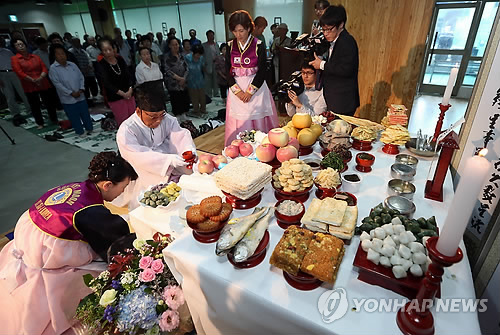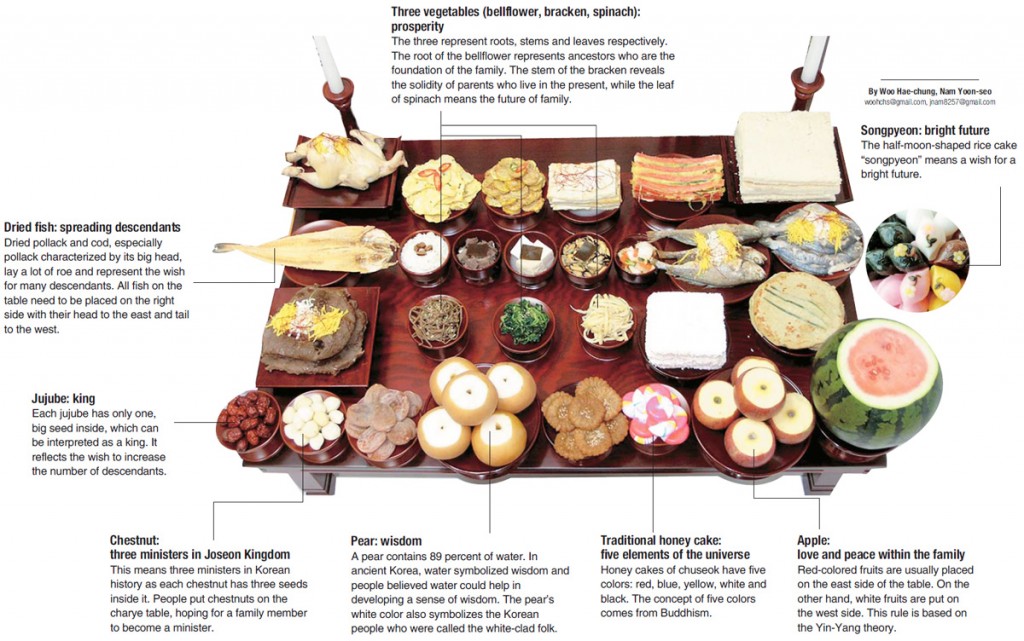- California Assembly OKs highest minimum wage in nation
- S. Korea unveils first graphic cigarette warnings
- US joins with South Korea, Japan in bid to deter North Korea
- LPGA golfer Chun In-gee finally back in action
- S. Korea won’t be top seed in final World Cup qualification round
- US men’s soccer misses 2nd straight Olympics
- US back on track in qualifying with 4-0 win over Guatemala
- High-intensity workout injuries spawn cottage industry
- CDC expands range of Zika mosquitoes into parts of Northeast
- Who knew? ‘The Walking Dead’ is helping families connect
Chuseok feast for ancestors

Senior citizens perform joint ancestral rites at a seniors hall in downtown Seoul on Sept. 5, 2014, ahead of Chuseok, which falls on Sept. 8.
By Woo Hae-chung, Nam Yoon-seo
The Chuseok holiday starts today and people are busy preparing for “charye,” one of the ancestral rites in the middle of the holiday.
To celebrate a good harvest and pay respects to their ancestors, all family members gather to hold a memorial service offering traditional dishes to the deceased.
“We observe charye to offer the first harvest of the season to our ancestors. That’s why people try to put the best dishes on the ancestor worshiping table,” said Kim Seo-yeon, a researcher at the Sejong Korean Traditional Food Institute.
The kinds of foods have changed a lot these days. Still, how to arrange the dishes on the table for the traditional meaning and how to bow remain unchanged.
The Korea Times took a look at a charye table with assistance from the researcher.
Songpyeon: bright future
The half-moon-shaped rice cake “songpyeon” means a wish for a bright future.
Songpyeon is made of newly harvested rice as chuseok is the day to thank ancestors and provide them with a sample of the newly harvested crops.
Jujube: king
Each “jujube” has only one, big seed inside, which can be interpreted as a king. It reflects the wish to increase the number of descendants.
Chestnut: three ministers in Joseon Kingdom
This means three ministers in Korean history as each chestnut has three seeds inside it. People put chestnuts on the charye table, hoping for a family member to become a minister.
Pear: wisdom
A pear contains 86 percent of water. In ancient Korea, water symbolized wisdom and people believed water could help in developing a sense of wisdom. The pear’s white color also symbolizes the Korean people who were called the white-clad folk.
Apple: love and peace within the family
Red-colored fruits are usually placed on the east side of the table. On the other hand, white fruits are put on the west side. This rule is based on the Yin-Yang theory.
Three vegetables (bellflower, bracken, spinach): prosperity
The three represent roots, stems and leaves respectively. The root of the bellflower represents ancestors who are the foundation of the family. The stem of the bracken reveals the solidity of parents who live in the present, while the leaf of spinach means the future of family.
Traditional honey cake: five elements of the universe
Honey cakes of chuseok have five colors: red, blue, yellow, white and black. The concept of five colors comes from Buddhism.
Dried fish: spreading descendants
Dried pollack and cod, especially pollack characterized by its big head, lay a lot of roe and represent the wish for many descendants. All fish on the table need to be placed on the right side with their head to the east and tail to the west.











![그룹 방탄소년단(BTS) [BTS 공식 트위터. 재판매 및 DB 금지]](http://www.koreatimesus.com/wp-content/uploads/2025/07/Untitled-5-copy-199x223.jpg)






John Ryder
September 25, 2015 at 1:02 AM
I have heard that certain foods must not be served at Chaejok. Is this true? If so, what are they?
Thanks!
John Ryder
September 25, 2015 at 1:04 AM
I have heard that certain foods cannot be served at Chaejok. Is this true? If so, what are they?
Thanks!
kelly
November 25, 2017 at 3:55 PM
yes..I like the basic concepts behind Second Life but it seems incredibly outdated and when I played it was intensely non-intuitive / user friendly to an extent that made EVE look like a game for toddlers. thanks from
togel online